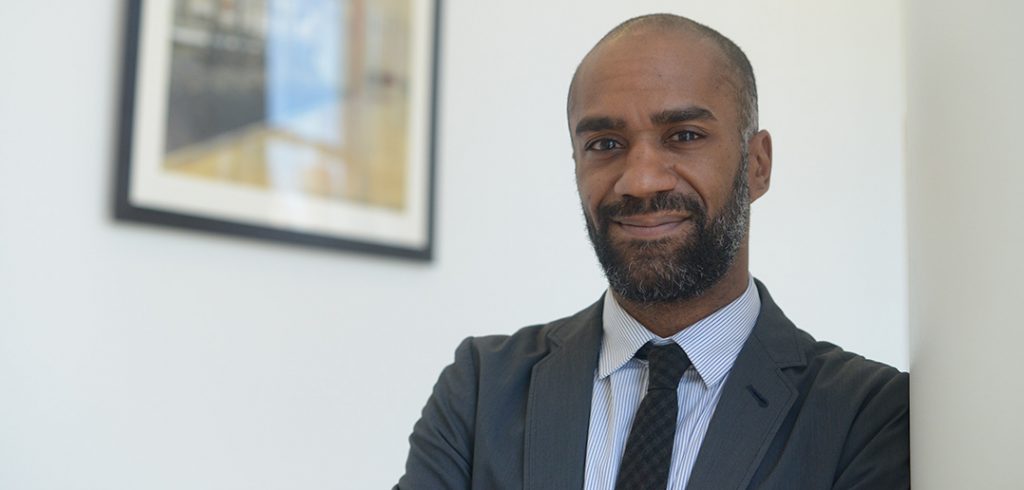For reasons that are not entirely clear, white and middle- and upper-class Americans generally access the Internet via desktop or laptop, but poor people and African Americans tend to use mobile devices.
That disparity is important as a matter of equity, if technology is going to be a tool for helping all people improve their lives, according to an expert at Fordham.
Social media, such as Tinder and Instagram, are well suited for mobile phones, as are certain games, said Olivier Sylvain, an associate professor of law who specializes in communications law and policy.
“But you can’t really write an essay on your smartphone, and you certainly can’t program [on it],” he said.
Such access issues are of particular interest to Sylvain. As a member of the law school’s new Center on Race, Law and Justice, he’s focused on making communications infrastructure part of the discussion about race and class disparities.
Some of the reasons for this disparity lie in the reality that certain wealthier neighborhoods are better served by Internet service providers (ISPs). Some of it is a facet of equipment cost: Internet-enabled mobile devices are simply more affordable than laptops or desktops. Cost issues explain differences in class, but not race, which Sylvain said could also be part of the sociological phenomenon: Your buddy gets a phone, so you get one too, and it’s just what you do.
The embrace of mobile technology, Sylvain pointed out, also opens up people—in this case more minorities—to greater surveillance by law enforcement. (Note the tussle being waged between Apple and the FBI over the iPhone of one of the San Bernardino shooters.)
“People of color are as susceptible as anyone to surveillance,” he said, but greater reliance on mobile “exacerbates existing forms of surveillance and discrimination.”
Sylvain tackles issues of unequal access by critiquing both government policies and the underlying assumptions that drive those policies. He says he supports the federal government’s policy of promoting network neutrality, which keeps ISPs from charging more for faster connectivity.
But he challenges the pro-neutrality principle that champions “innovation” as the reason for network neutrality.
Advocates claim that net neutrality led to the successes of Apple and Google, and tech companies used the “innovation” argument when they lobbied the Federal Communications Commission (FCC) to uphold net neutrality in 2014. They claim it creates a level playing field that helps new companies thrive, therefore bringing more connectivity to all.
But with what is essentially a trickle-down theory of Internet expansion, says Sylvain, “the FCC has chosen to celebrate the norm of innovation at the expense of equality and access.”
“Their argument was, when you have an open network, more people will innovate, and if more people will innovate, then more people will come to the Internet, and if more people come to the Internet, then more ISPs will invest in infrastructure, and will bring more service to more people. It’s a classic syllogism, and it makes sense,” Sylvain said.
“It’s a reasonable argument, and I support it, but it is an odd kind of exploitation of what is a far clearer mandate under the communications act—and that is to ensure that all people should have comparable access to services.”
In “Network Equality,” published last month in the Hastings Law Journal, Sylvain argues for relying instead on the principle of distributing access equally, and said the FCC has to encourage deployment of broadband Internet because it is so-bound by the Federal Communications Act of 1934.
Sylvain also says that making the Internet and other communications tools to everyone is eminently doable if the will exists. New York City recently signed an agreement with CityBridge, a consortium of private companies, to convert 7,500 old pay phones into free public Wi-Fi hot spots.
And in 2012, when Hurricane Sandy knocked out power and flooded large swaths of Red Hook, Brooklyn, the Red Hook Initiative community group deployed a wireless mesh network. It is a technology that spreads network connections among dozens of nodes that “talk” to each other and share network access across a large area, such as a neighborhood.
“[This example] underscores something important: The Internet exists,” Sylvain said. “You don’t necessarily need Time Warner or Verizon for the Internet, and if there are local communities that are empowered to do that everywhere, you speak to the issues that the FCC purports to be interested in, which is access and deployment.”
“There’s been a sort of fetishization of innovation for its own sake,” Sylvain said. “But for me, it depends on what you’re innovating for. In my mind, you should [innovate for]important core public norms of universal access and equality.”


